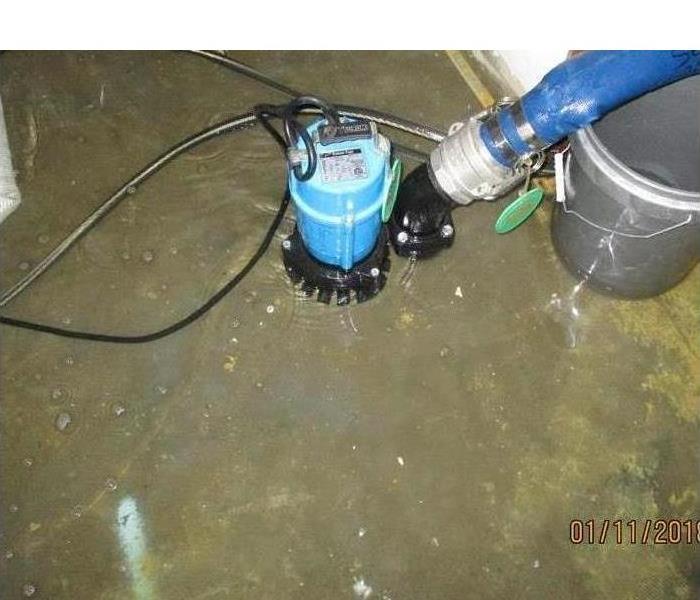What is the Best Way to Get Floodwater Out of a Sunken Den?
4/22/2020 (Permalink)
 SERVPRO extracts floodwaters from basements in the Glen Cove area with advanced equipment like this portable submersible pump
SERVPRO extracts floodwaters from basements in the Glen Cove area with advanced equipment like this portable submersible pump
SERVPRO technicians can remove the water quickly from your Glen Cove property
During a storm, there are numerous ways that water can enter a property in Glen Cove. When high winds damage a roof, the resulting leak is clean water, and as long as it gets cleaned up quickly, it poses no threat to inhabitants of the home. Groundwater is a far more severe issue. When this type of floodwater enters a home, it can have all kinds of bacteria, chemicals, and often sewage. Avoid coming into contact with it and get restoration services started as soon as possible.
What Should I Expect with Flood Damage Cleanup in My Home?
Flood damage in a Glen Cove den had numerous issues for SERVPRO technicians to address. Roughly an inch of water entered the home and quickly migrated into furnishings, flooring, and the structure. The technicians tested the water upon arrival to determine the nature of any bacteria or the presence of sewage (known as black water), so they could choose the proper cleaning agents to disinfect the worksite and make the cleanup process safer.
Part of Flood Loss Cleanup is Removal of Loss Items
The low-seated couch and loveseat in the den absorbed water from the wet carpet into the frame and stuffing and made them non-restorable as most porous items that take in black water cannot get returned to a sanitized condition for reuse. This meant they required removal as a loss with permission from the homeowner. Fortunately, a number of items had restoration potential. A solid wood coffee table got removed to another area for drying and cleaning. The accent pillows on the sofa remained dry and got moved outside the worksite with other items for cleaning and disinfection. The homeowner was pleased to find out the foosball table could get saved through washing with mild cleaners.
Frequently Seen Structural Damage After Flood Loss
Once water enters a home, the damage begins as it migrates and penetrates flooring and wicks into sheetrock. After quickly moving out the furnishings, the technicians scoped the den to determine all areas of water migration. They found it several inches into the sheetrock and wainscotting around the room. The techs measured over the water line on the walls and cut off the sheetrock several inches. This assists in drying the interior wall spaces.
Carpet wet from groundwater needs specific handling.
- Once black water gets found within the carpet, it requires removal and disposal as a biohazard.
- Due to the heaviness of wet carpet, the techs extract the water to make it safe to move.
- Once the maximum amount of moisture gets extracted, they cut the carpet into strips to make it easy to handle. This action exposes the concrete substrate, which needs attention to ensure it dries completely.
What is the Fastest Way to Dry Flood Damage in a Home?
Floodwater brings elevated humidity to the loss area that needs multiple pieces of equipment to remedy. SERVPRO technicians carry in different types of devices to deal with the moisture in the den.
- Portable pumps to pull as much water up as possible off most surfaces
- Rovers are valuable for removing the water from the carpet before disposal
- Squeegees work to push remaining water off the concrete
- Air movers blow at high speed and cause a chain reaction that results in embedded moisture in the concrete to rise
- Dehumidifiers seize this water vapor and remove it
- Monitoring during the entire drying process to maintain timelines and achieve drying goals
Handling Concerns for Electronics Exposed to Floodwater
After items such as the television and stereo equipment had exposure to the flood loss, the homeowner had concerns about their safety for reuse. Because it is not safe to test electronics with probable water exposure, the technicians arranged for a local industry expert to inspect the devices for the homeowner to reuse or if any repairs were necessary.
How to Removal Water Odors in a Home
Floodwater brings its own musty odor and may be made worse due to sewage or other elements in the water. Drying the property goes a long way towards lessening the foul scents in the home; however, the deodorizing cleaning agents also assist in the removal of any residual water odors. The use of antibacterial and antimicrobial cleaners as needed If needed, the technicians can use equipment such as air scrubbers and hydroxyl generators to capture any remaining airborne droplets and neutralize them. After the completion of these actions, the property is ready for the needed repairs to bring the den to its pre-water loss condition.
Flood damage needs immediate attention. Call SERVPRO of Glen Cove / Jericho at (516) 671-1919 for rapid action to restore your home and property.






 24/7 Emergency Service
24/7 Emergency Service